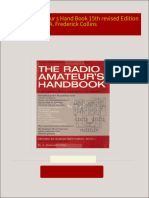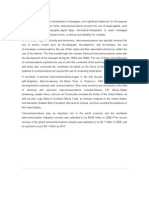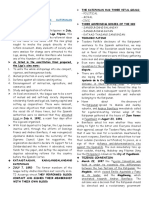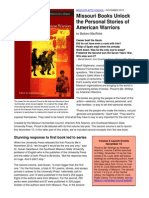0 ratings0% found this document useful (0 votes)
88 viewsTEMPEST: A Signal Problem
TEMPEST: A Signal Problem
Uploaded by
Chintan GhateThis document discusses the discovery of TEMPEST, where classified information processed by electronic equipment can be unintentionally emitted and intercepted. It describes how Bell Labs first discovered the issue in the 1940s while testing encryption machines. Through experiments, they identified radiation through space, magnetic fields, and conducted signals as risks and developed shielding, filtering, and masking techniques to mitigate them. However, the solutions made the machines impractical. Recognition of the full scope of the problem was slow, but countermeasures have gradually improved over time to reduce compromising emissions from equipment processing classified information.
Copyright:
Attribution Non-Commercial (BY-NC)
Available Formats
Download as PDF, TXT or read online from Scribd
TEMPEST: A Signal Problem
TEMPEST: A Signal Problem
Uploaded by
Chintan Ghate0 ratings0% found this document useful (0 votes)
88 views5 pagesThis document discusses the discovery of TEMPEST, where classified information processed by electronic equipment can be unintentionally emitted and intercepted. It describes how Bell Labs first discovered the issue in the 1940s while testing encryption machines. Through experiments, they identified radiation through space, magnetic fields, and conducted signals as risks and developed shielding, filtering, and masking techniques to mitigate them. However, the solutions made the machines impractical. Recognition of the full scope of the problem was slow, but countermeasures have gradually improved over time to reduce compromising emissions from equipment processing classified information.
Original Title
Tempest
Copyright
© Attribution Non-Commercial (BY-NC)
Available Formats
PDF, TXT or read online from Scribd
Share this document
Did you find this document useful?
Is this content inappropriate?
This document discusses the discovery of TEMPEST, where classified information processed by electronic equipment can be unintentionally emitted and intercepted. It describes how Bell Labs first discovered the issue in the 1940s while testing encryption machines. Through experiments, they identified radiation through space, magnetic fields, and conducted signals as risks and developed shielding, filtering, and masking techniques to mitigate them. However, the solutions made the machines impractical. Recognition of the full scope of the problem was slow, but countermeasures have gradually improved over time to reduce compromising emissions from equipment processing classified information.
Copyright:
Attribution Non-Commercial (BY-NC)
Available Formats
Download as PDF, TXT or read online from Scribd
Download as pdf or txt
0 ratings0% found this document useful (0 votes)
88 views5 pagesTEMPEST: A Signal Problem
TEMPEST: A Signal Problem
Uploaded by
Chintan GhateThis document discusses the discovery of TEMPEST, where classified information processed by electronic equipment can be unintentionally emitted and intercepted. It describes how Bell Labs first discovered the issue in the 1940s while testing encryption machines. Through experiments, they identified radiation through space, magnetic fields, and conducted signals as risks and developed shielding, filtering, and masking techniques to mitigate them. However, the solutions made the machines impractical. Recognition of the full scope of the problem was slow, but countermeasures have gradually improved over time to reduce compromising emissions from equipment processing classified information.
Copyright:
Attribution Non-Commercial (BY-NC)
Available Formats
Download as PDF, TXT or read online from Scribd
Download as pdf or txt
You are on page 1of 5
SCR'f'
(b) (3)-P.L. 86-36
TEMPEST: A Signal Problem
The story of the discovery
of various compromising radiations
from communications and Comsec equipment.
,i
.,
"i
1
1
I
\
!
In 1962, an officer assigned to a very smaJl intelligence
detachment in Japan was performing the routine duty of
inspecting the area around his little cryptocenter. As
required, he was examining a zone 200 ft. in radius to see
if there was any "clandestine technical surveillance."
Across the street. perhaps a hundred feet away, was a
hospital controlled by the Japanese government. He
sauntered past a kind of carport jutting out from one side of
the building and, up under the eaves, noticed a peculiar
thing-a carefully concealed dipole antenna, horizontally
polarized. with wires leading through the solid cinderblock
wall to which the carport abutted. He moseyed back to his
headquarters, then quickly notified the counter-intelligence
people and fired off a report of this "find" to Army Securi-
ty Agency, who. in turn, notified NSA. He was directed to
examine this antenna in detail and perhaps recover it, but
although the counter-intelligence folks had attempted to
keep the carport under surveillance that night, the antenna
had mysteriously disappeared when they checked the next
day. Up on the roof of the hospital was a forest of Vagi's,
TV antennae, all pointing towards Tokyo in the normal
fashion, except one. That one was aimed right at the U,S.
cryptocenter.
You may recall the highly publicized flap which
occurred in 1964 when more than 40 microphones were
discovered in the U.S. embassy in Moscow. Most people
were concerned about all the conversations that may have
been overheard and the resultant compromise of our
diplomatic plans and intelligence activities associated with
the embassy. We were concerned with something else:
What could those microphones do to the cryptomachines
used there? And what were the unpublirized gadgets also
found with microphones for? Why was there a large metal
grid carefully buried in the cement of the ceiling over the
Department of State communications area? A grid with a
wire leading off somewhere. And what was the purpose of
the wire that terminated in a very fine mesh of smaller hair.
like wires? And. while we were at it, how did these finds
relate to other mysterious finds and reports from behind
the Curtain-reports dating clear back to 1953?
Why, way back in 19:54, when the Soviets published a
rather comprehensive set of standards for the suppression
of radio frequency interference, were those standards much
more stringent for their teletypewriters and other
communications equipment than for such things as
diathermy machines, industrial motors, and the like, even
though the teletypewriters were much quieter in the first
place?
Behind these events and questions lies a long history
beginning with the discovery of a possible threat. the slow
recognition of a large number of variations of that threat,
and, lumbering along a few months or a few years
afterwards, a set of countermeasures to reduce or eliminate
each newweakness that has been revealed.
The Problem Defined
To state the general nature of the problems in brief:
Any time a machine is used to process classified
information electrically, the various switches, contacts.
relays, and other components in that machine may emit
radio frequency or acoustic energy. These emissions, like
tiny radio broadcasts. may radiate through free space for
considerable distances-a half mile or more in some cases.
26 SCItE'f" IIltlJ9Y VII. CarillA" EII:v."iY QtJIs
?r they may ~ e induced on nearby conductors like signal
lines, power lines, telephone lines, or water pipes and be
conducted along those paths for some distance- and here
we may be talking of a mile or more.
When these emissions can be intercepted and recorded,
it is frequently possible (0 analyze them and recover the
intelligence that was being processed by the source
equipment. The phenomenon affects not only cipher
machines but any information-processing
equipment-teletypewriters. duplicating equipment,
inrercornms, facsimile, computers-you name it. But it has
special significance for cryptomachines because it may
reveal not only the plain texts of individual menages being
processed but also that carefully guarded information about
the internal machine processes. Thus, conceivably, the
machine could be radiating information which could lead
to the reconstruction of our daily changing keying
variables-s-and from a Comsec viewpoint, that is absolutely
the worst thing that can happen to us. This problem of
compromising radiation we have given the covername
TEMPEST.
Discovery by Bell Lab
Now, let's go back to the beginning. During World
War II, the backbone systems for Army and Navy secure
teletypewriter communications were one-time tapes and
the primitive crypto-equipment SIGTOT. For encrypting,
the Services used a Bell-telephone mixing device, called
a 13 I -B2. When one of these mixers was being tested in
a Bell laboratory. a researcher noticed, quite by accident,
that each time the machine stepped, a spike appeared on an
oscilloscope in a distant part of the lab. After he examined
these spikes more carefully. he found that he could read the
plain text ofthe message being enciphered bythe machine!
Bell Telephone faced a dilemma. They had sold the
equipment to the military with the assurance that it was
secure, but it wasn't. The only thing they could do was to
tell rhe Signal Corps about it. which they did. There they
met the charter members of a dub of skeptics who could
not believe that these tiny pips could really be exploited
under practical field conditions. They are alleged to have
said something like: "Don't you realize there's a war on?
We can't bring our cryptographic operations to a
screeching halt based on a dubious and esoteric laboratory
phenomenon. If this is really dangerous, prove it." So. the
Bell engineers were placed in a building on Varick Street in
New York. Across the street and about 80 feet away was
Signal Corps' Varick Street cryptocenter. The engineers
recorded signals for about an hour. Three or four hours
later, they produced about 75 % of the plain text that was
5ECR'f'
being processed-a fast performance, by the way, that has
rarely been equalled. .
. The Signal Corps was impressed by this display and
directed Bell Labs to explore this phenomenon in depth
and provide modifications to the 131-B2 mixer to suppress
the danger. In a matter of six: months or so, Bell Labs had
identified three separate phenomena and suggested three
basic suppression measures:
(a) Shielding (for radiation through space, and
magneticfields)
(b) Filtering (for conducted signals on power lines,
signal lines, etc.)
(c) Masking (for either space-radiated or conducted
signals, but mostly for space)
Bell Labs went ahead and modified a mixer, calling it
the I31-A-1. In it they used both shielding and filtering
techniques. Signal Corps took one look at it and turned
thumbs down. The trouble was. to contain the offending
signals, Bell had to virtually encapsulate the machine.
Instead of a modification kit that could besent to the field,
the machines would have to be sent back and rehabilitated.
The encapsulation caused problems of heat dissipation.
made maintenance extremely difficult, and hampered
operations by limiting access to the various controls.
Instead of buying this monster, the Signal Corps resorted
to the only other solution they could think of. They went
out and warned commanders of the problem, advised them
to control a zone about 100 feet in diameter around their
communications center to prevent covert interception. and
let it go at that. And the cryptologic community as a whole
let it go at that for the next seven years or so. The war
ended; most of the people involved went back to civilian
life; the files were retired, dispersed, and destroyed. The
whole problem was, apparently, forgotten. Then, in 195 L,
the problem was, for all practical purposes, rediscovered by
CIA when they were toying with the same old 131-B2
mixer. They reported having read plain text about a
quarter mile down the signal line and asked if we were
interested. Of course, we were. Some power line and signal
line filters were built and immediately installed on these
equipments and they did the job pretty well as far as
conducted signals were concerned. Space radiation
continued unabated, however, and the first of many
"radiation" policies was issued in the form of a letter from
AFSA to all Sigint activities, requiring them to:
1. Control a zone 200 feet in all directions around
their cryptocenters, or
2. Operate at least 10 TTY devices simultaneously
(the idea of masking; putting out such a profusion of
signals that interception and analysis would be difficult), or
3. Get a waiver based on operational necessity.
IINJ9ibi '1'1.\ EebllN'F (I fAPUJEl:5 SIft:. SECRET 27
SECH'i"
j
ij
'I
j.
,I
\
Ii
I
!
i
!
The Sigint community conformed as best it could; and,
in some instances. general-service communicators adopted
similar rules. The figure of 200 feet. by the way, was quite
arbitrary. It had not been determined because we had hard
evidence that. beyond that distance. interception was
impractical; rather. it was the security zone we
believed the majority of stations could reasonably main-
rai n, and we knew that, with instrumentation then avail.
able, exploitation at that range would, at best, be exceed-
ingly difficult.
At the same time that we were trying to cope with the
13) -B2 mixer. we began to examine every other cipher
machine. Everytbing' tested radiated. and radiated rather
prolifically. With rotor machines. the voltage on their
power lines tended to fluctuate as a function of the number
of rotors moving. and so a fourth phenomenon, called
pourer line modllaltion, was discovered.
Progress in examining the machines and developing
suppression measures was very slow. By 1955, however, a
number of possible techniques for suppressing the
phenomena had been tried. FiJterin8 techniques were
refined somewhat; teletypewriter devices were modified so
that aUrelays operated at once and only a single spike was
produced with each character, instead of five smaller
spikes. representing each baud, but the size of the spike
changed with each character produced, and the analysts
could still read it quickly. A "balanced" ten-wire system
was tried which would cause each radiated signal to appear
identical. but to achieve and maintain such balance proved
impractical. Hydraulic techniques-to replace the
electrical-were tried and abandoned, and experiments
were made with different types of batteries and motor
in attempts to lick the power-line problem.
None was very successful.
During this period, the business of discovering new
TEMPEST threats. or refining techniques and
instrumentation for derecting, recording. and analyzing
these signals, progressed more swiftly than the art of
suppressing them. Perhaps the attack is more exciting than
the defense-something more glamorous about finding a
way to read one of these signals than going through the
drudgery necessary to suppress that whacking great spike
first seen in 1943. At any rate. when they turned over the
next rock. they found the acoustic problem under it.
Phenomenon No. '5.
Acoustics
We found that most acoustic emanations lire difficult to
exploit if the microphonic device is outside of the room
containing the source equipment; even a piece of paper
inserted between, say, an offending keyboa.rd and a pick-up
device, is usually enough to prevent sufficiently accurate
recordings to permit exploitation. Shotgun
microphones-the kind used to pick up a quarterback's
signals in a huddle-and large parabolic antennae are
effective at hundreds of feet-if there is a direct shot at
the equipment. The acoustic threat is, therefore. confined
to those installations where the covert interceptor can get
some kind of microphone-such as an ordinary telephone
that has been bugged or left off the hook-in the same
room with the information-processing device. We also
discovered that, when the room is "sound-proofed" with
ordinary acoustic tide, the job of exploitation is easier
because the sound-proofing cuts down reflected and
reverberating sound, providing clearer signals. A disturbing
discovery was that ordinary microphones. probably planted
to pick up conversations in a cryptocenter. could detect
machine sounds with enough fidelity to permit
exploitation. And such microphones were discovered in
Prague. Budapest, Warsaw and, of course. Moscow.
Seismics
28 SRT
II ViQhi VII. EI b\ffNEU er4t j
ii
b) (1)
(b)(3)-50 USC 403
(b) (3)-P.L. 86-36
Flooding
SfCftEY
IfJt14EiLE .. I,. t:BhrIlJT EIIAfJNEl:S 8NLY
SECRE'f' 29
(b) (1)
(b)(3)-50 USC
403
(b) (3)-18 USC
798
(b) (3)-P.L.
86-36
SECRET'
The TSEC KL-7A the versi n fth KL-7 modified
Anomalies
) (1)
)(3)-50 USC 403
(3)-P.L. 86-36
30 SECRET
(b) (1)
(b)(3)-50 USC 403
(b) (3)-P.L. 86-36
Jhtf4BLf lit eeft'Il' E. htf4l4EL5 8fJLY
b) (3)-P.L. 86-36
You might also like
- Telephone System in BuildingsDocument15 pagesTelephone System in BuildingsJonica Mae JomadiaoNo ratings yet
- Lib Ushistory Greek Mythology 27474 Article and QuizDocument5 pagesLib Ushistory Greek Mythology 27474 Article and QuizSayed MikoNo ratings yet
- HW33 PDFDocument13 pagesHW33 PDFFrancesca IannarilliNo ratings yet
- TEMPEST: A Signal ProblemDocument5 pagesTEMPEST: A Signal ProblemJoe Bloe100% (1)
- TempestDocument5 pagesTempestatulraut3773No ratings yet
- Introduction To Telecommunication Networks: 1.1 Historic Steps in The Telecommunication EraDocument65 pagesIntroduction To Telecommunication Networks: 1.1 Historic Steps in The Telecommunication EraZemenu BelieNo ratings yet
- Preface: Information TransmissionDocument71 pagesPreface: Information Transmissiondeshmukhneha679No ratings yet
- Mobilized Minds - A Quiz On Telecom - : PresentsDocument97 pagesMobilized Minds - A Quiz On Telecom - : Presentsapi-3775118No ratings yet
- Complete Unofficial Tempest PageDocument58 pagesComplete Unofficial Tempest PageDragos Moisa100% (1)
- Introd To EMCDocument72 pagesIntrod To EMCs.b.v.seshagiri1407No ratings yet
- Download full The Radio Amateur s Hand Book 15th revised Edition A. Frederick Collins ebook all chaptersDocument75 pagesDownload full The Radio Amateur s Hand Book 15th revised Edition A. Frederick Collins ebook all chaptersstxnerdanden100% (5)
- Tempest Impact Uk Us CommsDocument16 pagesTempest Impact Uk Us CommsYakov ZinovievNo ratings yet
- Evolution of Microwave CommunicationsDocument27 pagesEvolution of Microwave CommunicationsStephany Bryan Diez Itao67% (3)
- (U) Cryptologic Almanac 50 Anniversary Series (U) The Berlin TunnelDocument3 pages(U) Cryptologic Almanac 50 Anniversary Series (U) The Berlin TunnelSaul Elfenixx Onofre MartinezNo ratings yet
- Thirty YearsDocument30 pagesThirty YearsPaulo FernandesNo ratings yet
- History of TVDocument8 pagesHistory of TVtheused0477No ratings yet
- 03 March 1989Document108 pages03 March 1989Monitoring TimesNo ratings yet
- Solid State Physics & Devices - The Harbinger of Third Wave of Civilization - PREFACE - Unfolding of Third Information RevolutionDocument15 pagesSolid State Physics & Devices - The Harbinger of Third Wave of Civilization - PREFACE - Unfolding of Third Information RevolutionDeepak MitNo ratings yet
- Harper's Wireless BookDocument224 pagesHarper's Wireless Bookhds0405No ratings yet
- Compilation of TELECOM OSPDocument104 pagesCompilation of TELECOM OSPdanielcoralde825No ratings yet
- A History of Wireless Technologies: There Is Absolutely No Difference Between Radio and Wireless Except The SpellingDocument6 pagesA History of Wireless Technologies: There Is Absolutely No Difference Between Radio and Wireless Except The SpellingSudip BishwakarmaNo ratings yet
- Slayton Tty MuseumDocument24 pagesSlayton Tty Museumyoung-ThucidNo ratings yet
- FM CommunicationDocument144 pagesFM CommunicationAhmed Sakr (أحمد صقر)No ratings yet
- Number StationsDocument4 pagesNumber StationsdivNo ratings yet
- Instant Download Polymer Composites in The Aerospace Industry 2nd Edition P. E. Irving (Editor) PDF All ChapterDocument25 pagesInstant Download Polymer Composites in The Aerospace Industry 2nd Edition P. E. Irving (Editor) PDF All Chapterdynekkiillo100% (6)
- Short HistoryDocument4 pagesShort HistoryCaio FernandesNo ratings yet
- Remote ControllingDocument12 pagesRemote Controllinggvsr4187No ratings yet
- 26-07-23, 0813 Microsoft LensDocument5 pages26-07-23, 0813 Microsoft LensCésar CastilloNo ratings yet
- WHITEPAPER - Veronica Valeros and Sebastian Garcia - A Modern Study of Microphone BugsDocument14 pagesWHITEPAPER - Veronica Valeros and Sebastian Garcia - A Modern Study of Microphone BugsTina BillingsleyNo ratings yet
- Telecommunication Industrial SkillsDocument15 pagesTelecommunication Industrial SkillsAditya KapoorNo ratings yet
- The Romance of Modern Invention Containing Interesting Descriptions in Non-technical Language of Wireless Telegraphy, Liquid Air, Modern Artillery, Submarines, Dirigible Torpedoes, Solar Motors, Airships, &c. &c.From EverandThe Romance of Modern Invention Containing Interesting Descriptions in Non-technical Language of Wireless Telegraphy, Liquid Air, Modern Artillery, Submarines, Dirigible Torpedoes, Solar Motors, Airships, &c. &c.No ratings yet
- DJ5IL rt007Document14 pagesDJ5IL rt007altieric92No ratings yet
- UtDocument32 pagesUtsanthoshm123098No ratings yet
- The Radio Amateur's Hand Book: A Complete, Authentic and Informative Work on Wireless Telegraphy and TelephonyFrom EverandThe Radio Amateur's Hand Book: A Complete, Authentic and Informative Work on Wireless Telegraphy and TelephonyNo ratings yet
- TelecommunicationDocument9 pagesTelecommunicationNanee DevaNo ratings yet
- Mukesh VodafoneDocument84 pagesMukesh VodafoneRavi Kant VermaNo ratings yet
- Telecommunication Is The Transmission of Messages, Over Significant Distances, For The PurposeDocument18 pagesTelecommunication Is The Transmission of Messages, Over Significant Distances, For The PurposeMayank AgarwalNo ratings yet
- INVENTORSDocument3 pagesINVENTORSJameel GaviñoNo ratings yet
- ECEVSP L01 Intro ShareDocument60 pagesECEVSP L01 Intro ShareHuayiLI1No ratings yet
- 3 1 History of Networks Notes PDFDocument21 pages3 1 History of Networks Notes PDFprodigy1987No ratings yet
- The Early History of Radar: HistoricalDocument3 pagesThe Early History of Radar: HistoricalJC RTNo ratings yet
- Benefits of Standards in ComputingDocument14 pagesBenefits of Standards in ComputingUriahs VictorNo ratings yet
- History of TelecommunicationDocument21 pagesHistory of Telecommunicationdrnileshkarle5671No ratings yet
- History: Telecommunication IsDocument9 pagesHistory: Telecommunication IsswathipalaniswamyNo ratings yet
- History: Telecommunication IsDocument9 pagesHistory: Telecommunication IsswathipalaniswamyNo ratings yet
- Not Just A British Invention Cavity MagnetronDocument11 pagesNot Just A British Invention Cavity MagnetronMau BloembergenNo ratings yet
- The First RadioDocument4 pagesThe First RadioRobert LeoNo ratings yet
- 1908 Radio TelegraphyDocument300 pages1908 Radio TelegraphyKenneth LeakeNo ratings yet
- Principle of Communication G1Document132 pagesPrinciple of Communication G1Jhon Carlo FaustinoNo ratings yet
- Sec 2Document8 pagesSec 2Eng. Bagunda Yves DescartesNo ratings yet
- ECS455 - Premidterm - U2Document178 pagesECS455 - Premidterm - U2Adetunji TimileyinNo ratings yet
- Securing The Undersea Cable NetworkDocument16 pagesSecuring The Undersea Cable NetworkHoover InstitutionNo ratings yet
- History of Telegraph in CommunicationDocument2 pagesHistory of Telegraph in CommunicationQuynh Anh VoPhuongNo ratings yet
- History: Radar and ArpaDocument19 pagesHistory: Radar and Arpachan_1016No ratings yet
- Technological Breakthroughs of World War II: How War Changed Our WorldFrom EverandTechnological Breakthroughs of World War II: How War Changed Our WorldNo ratings yet
- The Hopkins BeastDocument18 pagesThe Hopkins BeastSigurko MatthewNo ratings yet
- A Brief History of TelecommunicationsDocument2 pagesA Brief History of TelecommunicationsvanNo ratings yet
- Historical Setting: The Pre-Electromagnetic PastDocument5 pagesHistorical Setting: The Pre-Electromagnetic PastRandy Owen Javier CosmeNo ratings yet
- EchelonDocument14 pagesEchelonWigan PatriotNo ratings yet
- The Radio Amateur's Hand Book A Complete, Authentic and Informative Work on Wireless Telegraphy and TelephonyFrom EverandThe Radio Amateur's Hand Book A Complete, Authentic and Informative Work on Wireless Telegraphy and TelephonyNo ratings yet
- Physics Group 5 & 6Document32 pagesPhysics Group 5 & 6LELINo ratings yet
- St. PetersburgDocument42 pagesSt. Petersburgmylefthand_surgeon100% (1)
- FOUNDATION OF OTTOMAN STATE by Halil INALCIKDocument29 pagesFOUNDATION OF OTTOMAN STATE by Halil INALCIKAlperBalcı100% (2)
- Discover The Unknown RhodesDocument82 pagesDiscover The Unknown RhodesBluegr Mamidakis Hotels100% (3)
- UNIT 1 English 5 (Co Ban & Nang Cao)Document18 pagesUNIT 1 English 5 (Co Ban & Nang Cao)27. Hồng NhungNo ratings yet
- Exile PoetryDocument2 pagesExile PoetryMuntaha FawadNo ratings yet
- Armor Magazine, March-April 1992Document56 pagesArmor Magazine, March-April 1992"Rufus"100% (2)
- Asymmetric Cyber-Warfare Between Israel and Hezbollah: The Web As A New Strategic BattlefieldDocument4 pagesAsymmetric Cyber-Warfare Between Israel and Hezbollah: The Web As A New Strategic BattlefieldKiran KumarNo ratings yet
- Chris ResumeDocument3 pagesChris Resumeapi-273332711No ratings yet
- Act 4 Scene 3Document6 pagesAct 4 Scene 3Jhenkar Cm0316No ratings yet
- What Is TerrorismDocument27 pagesWhat Is TerrorismYasmine MattarNo ratings yet
- 1892, Rizal Organized The La Liga Filipina, This: Confronting Colonialism: Katipunan and The Revolution of 1896Document13 pages1892, Rizal Organized The La Liga Filipina, This: Confronting Colonialism: Katipunan and The Revolution of 1896Julie Ann Barsalote GubaNo ratings yet
- PDFDocument218 pagesPDFChandreyeeChakrabortyNo ratings yet
- Appeasement Policy Cartoon Analysis S3Document4 pagesAppeasement Policy Cartoon Analysis S3Niko BellicNo ratings yet
- Army Aviation Digest - Apr 1972Document68 pagesArmy Aviation Digest - Apr 1972Aviation/Space History LibraryNo ratings yet
- Albert Einstein Old Grove D. Nassau Point Peconic, Long IslandDocument2 pagesAlbert Einstein Old Grove D. Nassau Point Peconic, Long Islandapi-26040189100% (1)
- Cont HistoryDocument169 pagesCont HistoryCTN2010100% (1)
- WwiiDocument76 pagesWwiiAnonymous ZQFu7xW100% (1)
- BIO127 Questions 8Document4 pagesBIO127 Questions 8HarliNo ratings yet
- Reading and WritingDocument30 pagesReading and WritingRonald Pacquiao Macasero100% (2)
- T2 Junior 1BR - STEP UP PROMODocument1 pageT2 Junior 1BR - STEP UP PROMOLiv ValdezNo ratings yet
- Evolution of Heritage Town Pondicherry PDFDocument21 pagesEvolution of Heritage Town Pondicherry PDFAtshayaNo ratings yet
- Archaon - 2021-12-21 BattlescrollDocument1 pageArchaon - 2021-12-21 Battlescrollleneyik753No ratings yet
- Shadow Cell 13 HCDDocument6 pagesShadow Cell 13 HCDapi-328331072No ratings yet
- CV Jamal Rosi New 2018Document1 pageCV Jamal Rosi New 2018berd zainNo ratings yet
- Suny The Contradiction of IdentitiesDocument20 pagesSuny The Contradiction of IdentitiesLuka SaladzeNo ratings yet
- Activity 5b 1Document3 pagesActivity 5b 1KaguraNo ratings yet
- SAT Essay Writing - My ExamplesDocument5 pagesSAT Essay Writing - My ExamplesDzung PhamNo ratings yet
- Missouri Arts Council November 2013Document13 pagesMissouri Arts Council November 2013AhmadGhanemNo ratings yet

























































































